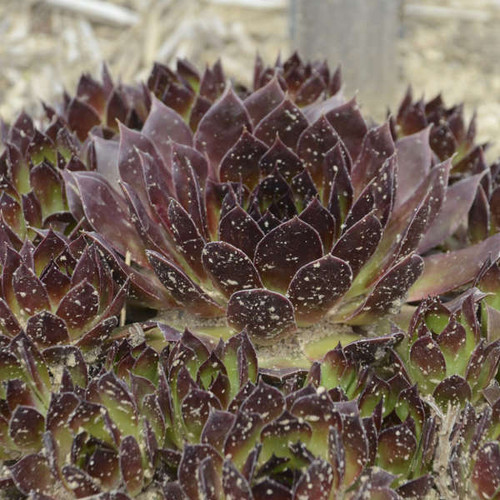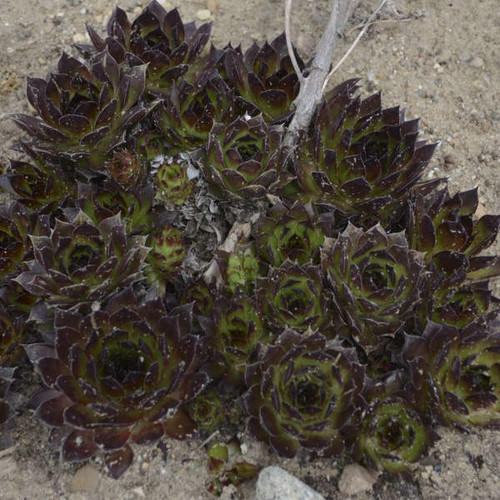Product Description
Sempervivum 'Pacific Blue Ice' (25) Bare Root Plantss
Common Name: Hen & Chicks, Houseleek
Sempervivum is comprised of one large rosette called the "hen" which sprouts many smaller rosettes around it called "chicks". As the plants age, the "hen" may die out and be replaced by the "chicks". Plants can be divided easily at any time by pulling up some of the "chicks" and replanting them elsewhere.
This plant is particularly effective when planted in the cracks and crevices of stone walls or walkways. It is also very attractive in containers. The name Sempervivum means "live forever".
Sempervivum is the perfect plant for hot, dry, sunny locations with very well-drained soil. Though they can adapt to a variety of soil types, they perform best in gritty soil. If a groundcover effect is desired, space plants close together because they grow slowly.
Height: 3.0-4.0 Inches
Spread: 6.0-8.0 Inches
Hardiness Zones: 3,4,5,6,7,8
Foliage Color: Blue shades
Full Sun
Low Water Needs
Poor to Average Soil Quality
Bloomtime: Midsummer
Deer and Rabbit Resistant
Evergreen
Growth Rate: Slow
Border Plant, Container, Drought Tolerant, Easy To Grow, Ground Cover, Salt Tolerant, Small. Miniature
Sempervivum 'Pacific Blue Ice' is a captivating succulent prized for its striking blue-gray foliage and unique rosette form. Here is a breakdown of its key characteristics:
Appearance:
- Rosettes: Forms tight, symmetrical rosettes of thick, fleshy leaves. The leaves are a beautiful blue-gray color, often with a slight powdery or frosted appearance. New growth can sometimes have a purplish tint.
- Size: Typically grows to about 4-6 inches in diameter, forming a low-growing, spreading mat over time.
- Flowers: While the foliage is the main attraction, Sempervivum 'Pacific Blue Ice' does produce flower stalks. These stalks emerge from the center of the rosette and bear clusters of small, star-shaped pink or reddish flowers. However, the rosettes that produce flowers will die back afterward, though they leave behind offsets (also called "chicks") to continue the colony.
Growing Conditions:
- Sunlight: Prefers full sun (at least 6 hours of direct sunlight daily) to maintain its vibrant blue color and compact form. It can tolerate some light shade, but the color may be less intense.
- Soil: Thrives in well-drained soil. This is crucial, as soggy soil will lead to root rot. A gritty or sandy soil mix is ideal.
- Water: Extremely drought-tolerant once established. Water sparingly, allowing the soil to dry out completely between waterings. Overwatering 1 is the most common cause of problems.
- Hardiness Zones: Generally hardy in USDA zones 3-10, making it adaptable to a wide range of climates.
- Temperature: Tolerates a wide range of temperatures, including frost.
Benefits:
- Unique Foliage: The striking blue-gray color and rosette form add a distinctive touch to the garden.
- Low Maintenance: Extremely easy to care for, requiring minimal attention.
- Drought Tolerant: Ideal for dry gardens, rock gardens, or areas with limited water.
- Deer Resistant: Generally, not bothered by deer.
- Versatile: Can be grown in the ground, in containers, or even in crevices in rocks or walls.
- Propagation: Easily propagated by separating the offsets (chicks) from the mother plant.
Care Tips:
- Planting: Plant in well-drained soil in a sunny location. Space plants about 6-8 inches apart to allow for spreading.
- Watering: Water sparingly, especially during the growing season. Reduce watering in the winter.
- Fertilizing: Generally, does not require fertilization.
- Repotting (for containers): Repot only when necessary, as Sempervivums prefer to be somewhat root-bound. Use a well-draining potting mix.
- Propagation: Gently remove offsets (chicks) from the mother plant and plant them in well-drained soil.
Sempervivum 'Pacific Blue Ice' is a fantastic choice for gardeners looking for a low-maintenance, visually appealing succulent. Its unique color and form make it a standout in any garden setting.
Other Details
The most important part of the plant is its root system. Healthy roots are the foundation of a healthy, vibrant plant. The type of plug container used is based on the specific needs of the plants. Perennials offered as bare root traditionally perform better when planted as bare root.Planted in a specialized mix, potted plants have well established root systems. Top growth stage will vary depending on the current life cycle and time of year when shipped. In Winter and early Spring dormant plants may be shipped. Dormant plants may be planted right away, even before the last frost date.
Most bare root varieties are field grown for at least one season, though Hemerocallis and Hosta are grown for two seasons. The bulk of the soil is removed during the harvesting process and the tops of most varieties are trimmed back to the crown. They are graded, packed in shredded aspen or sphagnum moss and stored in freezers until ready to be shipped.
See our Container Sizes and Bare Root Perennials pages for more information.
Plant information and care is provided in the Overview section, Plant Genus Page and general information is provided in the Planting Care & Guides. Additional questions can be asked on each Plant page.
Plant Spacing: Using the maximum mature spread or width of a plant to guide spacing, ensures space to grow to full size. To fill an area sooner, plant them closer together. Just remember, future thinning or transplanting may be needed.
Water: Keep a close eye on newly planted perennials, especially throughout the first growing year. Most early plant loss is due to too much or too little water!











